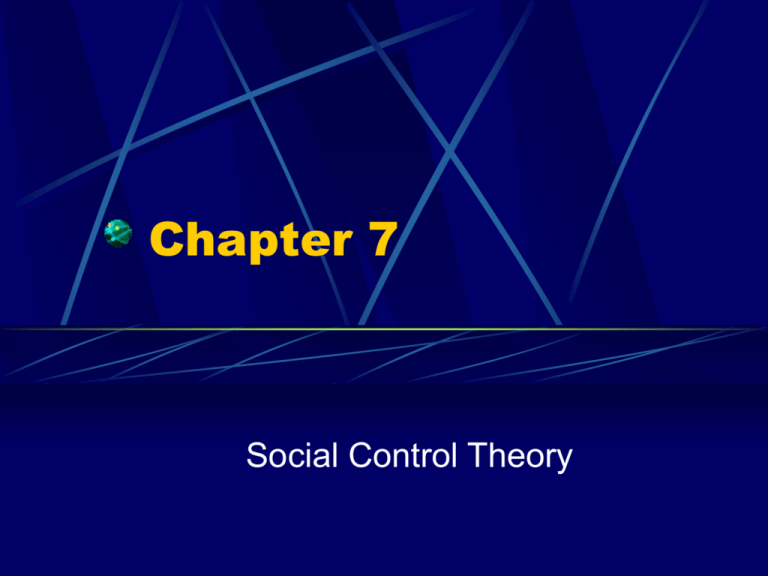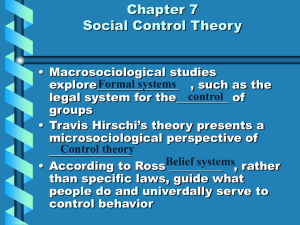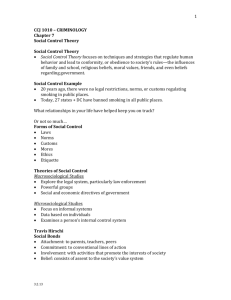
Chapter 7
Social Control Theory
Social Control
The key question they try to answer is not, Why do
people become criminals? But rather, Why do people
not become criminals?
Social Control Theory focuses on techniques and
strategies that regulate human behavior and lead to
conformity, or obedience to society’s rules.
Social control theories maintain that all people have
the potential to violate the law and that modern
society presents many opportunities for illegal
activity.
Copyright © 2007 by The McGraw-Hill Companies, Inc. All Rights Reserved.
Social control theorists argue that people
obey the law because behavior and passions
are being controlled by internal and external
forces.
Most people have developed a strong moral
sense, which prevents them from violating
social norms.
Copyright © 2007 by The McGraw-Hill Companies, Inc. All Rights Reserved.
Travis Hirschi
Social Bonds
Travis Hirschi’s social bonding theory may be
the most popular criminological theory today.
First presented in 1969, Hirschi questioned
why people do not commit crime.
Hirschi theorized that crime is more common
among individuals with weakened bonds to
societal institutions.
Copyright © 2007 by The McGraw-Hill Companies, Inc. All Rights Reserved.
Travis Hirschi
Social Bonds
Attachment: to parents, teachers, peers
- Attachment to parents is the most important
- affection deters criminal activities
- Strength depends on the depth and quality
of parent-child interaction
Commitment: to conventional lines of action.
- vocational aspirations, educational
expectations and aspirations
Copyright © 2007 by The McGraw-Hill Companies, Inc. All Rights Reserved.
Involvement: with activities that promote the
interests of society
- A busy person doing conventional things
has little time for deviant activities.
Belief: consists of assent to the society’s
value system
- respect of its laws and for the people and
institutions that enforce them.
Copyright © 2007 by The McGraw-Hill Companies, Inc. All Rights Reserved.
Neutralization and Drift
Theory
David Matza and Gresham Skyes developed
neutralization theory.
Matza argues that even the most committed
criminals and delinquents are not involved in
criminality all the time.
They drift in and out of conventional and
criminal behavior.
Copyright © 2007 by The McGraw-Hill Companies, Inc. All Rights Reserved.
Neutralization and Drift
Theory
Guilt and same lie at the center of
neutralization theory.
To counter guilt or shame, adolescents need
to neutralize those feelings by developing at
least one of five rationalizations or techniques
of neutralization about why it is OK to break
the law
Copyright © 2007 by The McGraw-Hill Companies, Inc. All Rights Reserved.
David Matza
Delinquency and Drift
Techniques of neutralization:
1. Denial of Responsibility – behavior is due to
forces beyond their control
2. Denial of Injury – no one was hurt
3. Denial of the Victim – they deserved it
4. Condemnation of the Condemner – they
made me do it.
5. Appeal to Higher Loyalties – I had no
choice.
Copyright © 2007 by The McGraw-Hill Companies, Inc. All Rights Reserved.
Walter Reckless
Containment Theory
Containment Theory assumes that for every
individual there exists a containing external
structure and a protective internal
structure, both of which provide defense,
protection, or insulation against
delinquency.
Copyright © 2007 by The McGraw-Hill Companies, Inc. All Rights Reserved.
Walter Reckless
Containment Theory
Reckless suggests that the probability of
deviance is directly related to the extent to
which internal pushes, and external pulls are
controlled by one’s inner and outer
containment.
The primary containment factor is found in
self-concept
Copyright © 2007 by The McGraw-Hill Companies, Inc. All Rights Reserved.
Containment Theory
Outer containment
A role that guides a
person’s activity
Reasonable limits and
responsibilities
Opportunity to achieve
status
Cohesion among members
of group.
Sense of belongingness
Inner Containment
A good self-concept;
Self-control;
A strong ego;
Well-developed
conscience;
High frustration
tolerance
High sense of
responsibility
Copyright © 2007 by The McGraw-Hill Companies, Inc. All Rights Reserved.
Albert J. Reiss
Delinquency is the result of
1. a failure to internalize socially
accepted and prescribed norms of
behavior,
2. a breakdown of internal controls; and
3. a lack of social rules that prescribe
behavior in the family, the school, and
other important social groups.
Copyright © 2007 by The McGraw-Hill Companies, Inc. All Rights Reserved.
General Theory of Crime
Travis Hirschi and Michael Gottfredson
Designed to explain an individual’s
propensity to commit crime
Assumes that the offenders have little
control over their own behavior and
desires
Crime is a function of poor self-control
Copyright © 2007 by The McGraw-Hill Companies, Inc. All Rights Reserved.
Individuals with low self-control tend to
be involved in noncriminal events that
result in harm such as
1. drinking and smoking
2. And most types of accidents including
auto crashes, household fires, and
unwanted pregnancies.
Copyright © 2007 by The McGraw-Hill Companies, Inc. All Rights Reserved.








